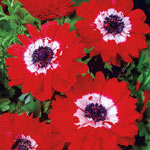Anemones
Anemones, sometimes called windflowers, provide whimsy and cheer to the garden. These easy-to-care-for flowers offer bright color low to the ground, and they're both beautiful and drought tolerant. These set-and-forget flowers are perfect for beginners.
When Should You Plant Anemone Bulbs?
Anemone bulbs are best planted in the fall to allow the bulbs to establish roots before springtime sprouting. Soak your anemone bulbs in water overnight before planting. Each bulb should be planted 4-6 weeks before the first expected frost, but if you are located in a warmer area, you may plant the bulbs closer to the end of Autumn or early Winter. Check out our zone finder to locate which area you may be in.How Do You Plant Anemone Bulbs?
Native to the Mediterranean, anemone flowers are as rugged as they are beautiful. Resistant to insects, pests, and disease, anemone bulbs are drought tolerant as well as shade-tolerant and need little maintenance once planted. Depending on the variety, set them about 3 inches deep, and space them 3-4 inches apart. Water moderately throughout the growing season.Where To Plant Anemone Bulbs
It's hard to believe that sunny-looking anemones actually prefer a bit of shade. Choose a location with afternoon shade and morning sun, if possible, or try planting poppy anemones under a tree or arbor for dappled shade. Anemones thrive in lightweight, well-draining soil with slight acidity. Choose a spot without standing water, and add loam or sand to improve drainage.As you ponder where to plant your anemones, think about design as well as shade and soil requirements. Anemones offer clear, bright colors and a low-growing habit, perfect for filling in shady beds. Anemones tend to multiply, making them a pleasing choice for ground cover. Pair these bright plants with other shade-tolerant, woodland varieties like lily-of-the-valley or sweet pea, or use them to fill in among late-spring bulbs like tulips or fritillaria.










